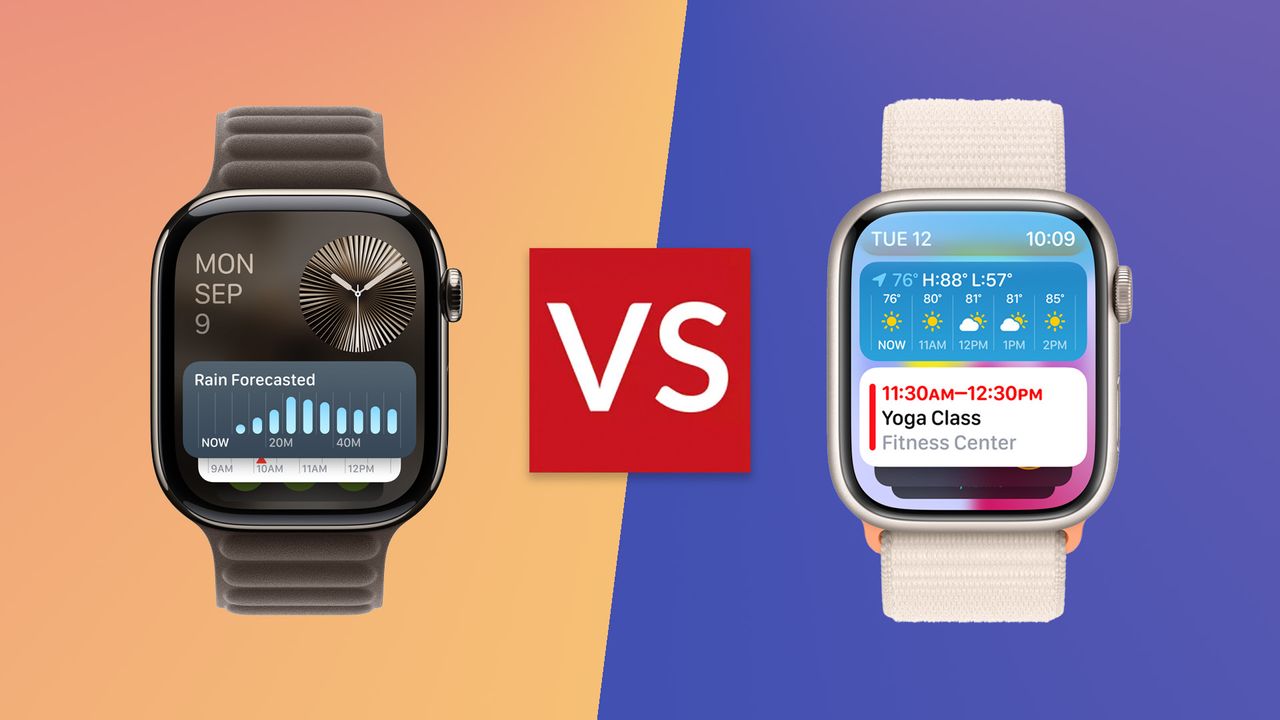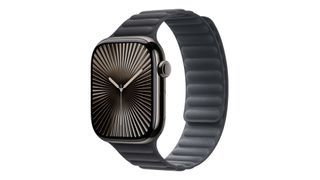

The Apple Watch Series 10 and Series 9 are the latest iterations of Apple’s immensely popular smartwatch line, each packed with cutting-edge technology designed to enhance your daily life. Here, we compare the two so, hopefully, you can make a more educated decision about which one to get.
The Apple Watch Series 9 was already a significant upgrade with its S9 chip, advanced fitness features, and sleek design. However, Apple has pushed the envelope even further with the Series 10, which features a larger screen, a slimmer profile, and even more robust health-tracking capabilities.
At first glance, these two models seem quite similar, but subtle differences in design and functionality make each unique. The Series 10 introduces a larger display – up to 9% bigger than the Series 9 – while also reducing the overall thickness by almost 10%, creating a more modern, streamlined look.
Beyond the aesthetics, the Series 10 is packed with additional features like sleep apnea detection, which makes it a strong contender for the title of the best Apple Watch. Meanwhile, the Series 9 continues to deliver strong performance at a more affordable price, making it a solid option for those who don't need the latest upgrades.
In terms of performance, both models are powered by Apple’s SiP chips – the S9 for the Series 9 and the S10 for the Series 10 – each with a four-core Neural Engine that enhances everything from app performance to on-device Siri.
However, the Series 10 takes it a step further with additional features like faster charging and an upgraded Ultra Wideband chip, making it even more convenient for busy, tech-savvy users. These enhancements build on the solid foundation of the Series 9, which already excels in fitness tracking, health monitoring, and seamless integration with Apple’s ecosystem.
Is it worth upgrading from the Series 9, or should you skip the current iteration and wait for the next generation? Let's find out.
Sign up to the T3 newsletter for smarter living straight to your inbox
Get all the latest news, reviews, deals and buying guides on gorgeous tech, home and active products from the T3 experts
Apple Watch Series 10 vs Series 9
Price and availability
The Apple Watch Series 9 starts at $399 in the US for the 41mm GPS aluminium model, while the 45mm version is priced at $429. If you opt for the GPS + Cellular versions, they cost $499 and $529 for the 41mm and 45mm models, respectively. For those wanting a more premium build, the stainless steel case model begins at $699 for the 41mm size.
In the UK, the pricing mirrors this structure, with the 41mm GPS aluminium model priced at £399 and the 45mm at £429. The GPS + Cellular models are £499 and £529, with the stainless steel variant starting from £699.
Over in Australia, the 41mm GPS aluminum model starts at AU$649, while the 45mm version is AU$699, and the GPS + Cellular models are AU$799 and AU$849. The stainless steel case starts at AU$1,199.
For the Apple Watch Series 10, pricing is slightly higher due to the updated design and features. In the US, the 42mm GPS aluminium model starts at $429, while the 46mm is priced at $449. The GPS + Cellular versions cost $529 and $549 for the 42mm and 46mm models, respectively. The titanium case models, which replace the stainless steel option from Series 9, start at $799.
In the UK, the 42mm GPS aluminium model is priced at £429, and the 46mm at £449. GPS + Cellular models are £529 and £549, while the titanium model starts at £799.
In Australia, prices for the 42mm GPS aluminum model start at AU$699, while the 46mm is AU$749. The GPS + Cellular models cost AU$849 and AU$899, and the titanium model starts at AU$1,249.
These price differences reflect the Series 10's enhancements, including a larger display, thinner profile, and premium titanium casing, as well as new health tracking features that make it more advanced than the Series 9. However, both models continue to offer Apple's signature build quality and functionality at different price points.
For the best prices, check out T3's cheap Apple Watch deals roundup. Head over to Apple to see the full Apple Watch lineup currently available.
Key specs compared
| Row 0 - Cell 0 | Apple Watch Series 10 | Apple Watch Series 9 |
| Available sizes | 42mm, 46mm | 41mm, 45mm |
| Display type | Wide-angle LTPO3 OLED | LTPO OLED |
| Maximum brightness | 2,800 nits | 2,000 nits |
| Chipset | S10 SiP | S9 SiP |
| Ultra Wideband? | Yes, 2nd Gen | Yes, 2nd Gen |
| Gesture control | Double Tap | Double Tap |
| Battery life | Up to 18 hours | Up to 18 hours |
| Storage | 64GB | 64GB |
The most notable differences are the slight size increase and the more advanced display in the Series 10, which is 9% larger and significantly brighter than its predecessor. This makes for improved readability, especially when viewed from an angle. Additionally, the S10 chip promises enhanced performance and efficiency, though the day-to-day impact might be negligible for most users.
Design and build quality

The Apple Watch Series 9 retains the iconic design of previous models, with 41mm and 45mm case sizes. It features a bright LTPO OLED display, available in aluminum and stainless steel finishes.
The watch offers the same digital crown and side button layout as before, and supports new colour options like pink. The Series 9 is powered by the S9 SiP and includes a 2nd-gen Ultra Wideband chip. It supports gesture controls like Double Tap and on-device (offline) Siri, making it more responsive and intuitive.
The Apple Watch Series 10 introduces a sleeker, thinner design with slightly larger 42mm or 46mm cases. The display is 9% larger than the Series 9, utilising a wide-angle LTPO3 OLED screen for improved brightness and readability. It’s said to be bigger than the Apple Watch Ultra 2’s screen.
The new display isn't only larger but also more energy efficient. Whereas before, the screen only refreshed once a minute when not active, the Series 10's display updates once a second, meaning you can see the second hand ticking away even with your wrist down. We're getting closer to a true, always-on display that doesn't eat battery life!

The Apple Watch Series 10 (re)introduces the titanium case option, available in natural, gold, and slate finishes. It offers a lightweight, durable design, making it 20% lighter than the stainless steel variant. The titanium case also provides high resistance to corrosion and is ideal for those seeking a premium look and feel with superior durability.
The integrated antenna is positioned to enhance connectivity while maintaining the streamlined, sleek design.
The speaker has also been upgraded. While specific size details aren’t readily available, the Series 10’s speaker is designed to deliver better audio clarity and volume, especially when using features like Apple Music, Podcasts, or when making calls via FaceTime.
The speaker enhancements also support the watch’s capability to act as a microphone for phone calls and FaceTime, with built-in noise suppression for clearer communication.
Strap options are interchangeable between the two, with both supporting a range of bands from Apple’s extensive collection.
Features: health, fitness, and smart capabilities

The Double Tap gesture was introduced on the Series 9
Both models are powerhouses when it comes to health and fitness features. You’ll find the usual heart rate monitoring, ECG, blood oxygen tracking, and a temperature sensor on both models.
Both the Apple Watch Series 9 and Series 10 run on watchOS 11, which introduces several key features. These include customisable new watch faces and improved Smart Stacks widgets for easier app access. Both models support on-device Siri, allowing faster access to health data without needing cloud servers.
The Mindfulness app has also been updated to focus on mental well-being. While the Series 9 and Series 10 share most features, sleep apnea detection is exclusive to the Series 10 hardware.
A key feature introduced with Series 9, the double-tap gesture control, carries over to the Series 10, allowing users to interact with the watch without touching the screen.
The Apple Watch Series 10 is optimised for water sports with its advanced water resistance rating, allowing it to withstand depths of up to 50 meters. Additionally, it features a built-in depth gauge, which can measure depths up to 6 meters, making it suitable for activities like swimming, snorkelling, and shallow diving. The watch also includes a water temperature sensor, helping users monitor environmental conditions while engaging in water-based activities.
Battery life and charging
Battery life remains consistent across both models, with an estimated 18 hours in regular use and up to 36 hours in Low Power Mode. However, the Series 10 edges out slightly in terms of charging speed, reaching 80% charge in just 30 minutes, compared to the Series 9’s 45 minutes.
For comparison, the Samsung Galaxy Watch 7 provides up to 40 hours of battery life with the always-on display (AOD) turned off, and about 30 hours with it on. However, the charging speed is slower, with fast charging replenishing ‘only’ 50% of battery life in around 30 minutes.
The Google Pixel Watch 3 offers around 24 hours of battery life with the Always-On Display (AOD) enabled and up to 36 hours in Battery Saver Mode. Charing speed is the same as the Galaxy Watch 7, topping the watch up to 50% in 3 minutes.
Verdict: which is better?

Is the Series 10 the best Apple Watch yet? It sure is. However, both the Apple Watch Series 9 and Series 10 are outstanding smartwatches, each with its own set of strengths.
The Series 9 remains a strong contender, especially considering its lower price and extensive feature set. For those who don’t need the absolute latest technology, it’s an excellent choice and offers fantastic value.
For those looking for the latest in wearable tech, the Series 10 offers tangible improvements in display size, brightness, performance metrics for athletes, and additional health features like sleep apnea detection. If you’re heavily into fitness or want a future-proof device, the Series 10 is worth the investment.
The larger display is tempting, but unless you're Series 9 is all scuffed up, we would suggest not upgrading for the environment's sake, if for nothing else. If you have an older Apple Watch, maybe a Series 7 or earlier version, upgrading to the Series 10 will make it feel like your wrist wearable has been supercharged, so you should definitely consider swapping them.
In conclusion, if budget is your priority, the Series 9 is still an excellent, capable watch. But if you’re after the cutting edge of technology and don’t mind spending a bit more, the Series 10’s enhancements will serve you well into the future.

Matt Kollat is a journalist and content creator who works for T3.com and its magazine counterpart as an Active Editor. His areas of expertise include wearables, drones, fitness equipment, nutrition and outdoor gear. He joined T3 in 2019. His byline appears in several publications, including Techradar and Fit&Well, and more. Matt also collaborated with other content creators (e.g. Garage Gym Reviews) and judged many awards, such as the European Specialist Sports Nutrition Alliance's ESSNawards. When he isn't working out, running or cycling, you'll find him roaming the countryside and trying out new podcasting and content creation equipment.
-
 Xiaomi just revealed one of the most interesting EVs of the year
Xiaomi just revealed one of the most interesting EVs of the yearThe Xiaomi SU7 Ultra is a Chinese EV ready to take on Porsche and Tesla
By Alistair Charlton Published
-
 Two dumbbells, 30 minutes, and six exercises to build muscle all over and a stronger core
Two dumbbells, 30 minutes, and six exercises to build muscle all over and a stronger coreA simple home workout to add muscle all over and boost strength
By Bryony Firth-Bernard Published